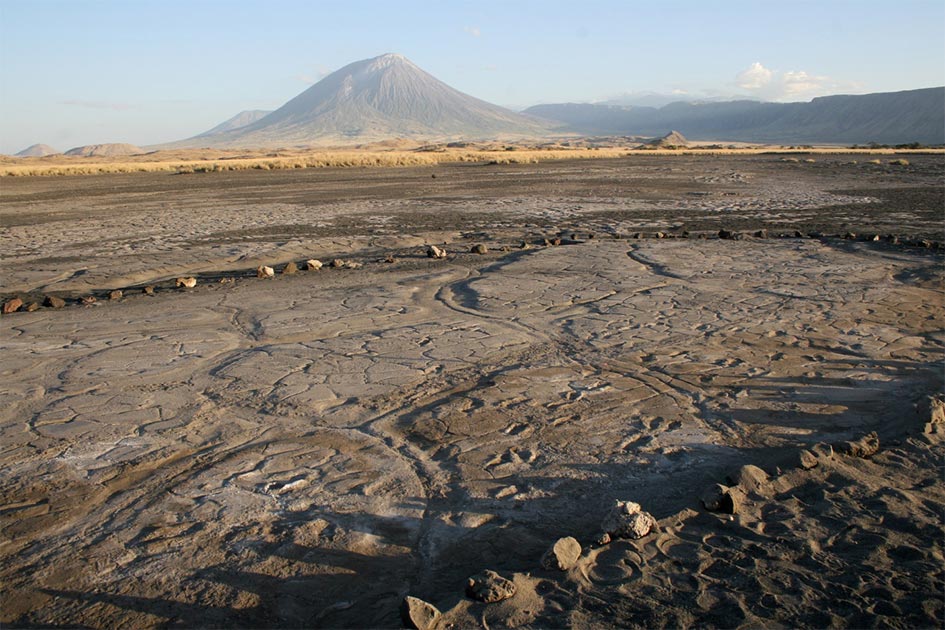400 Prehistoric Footprints Reveal Clues to Our Ancestors
Scientists reveal a volume of new data about the group of hunter-gatherers who left their prehistoric footprints in mud.
In the shadow of the Ol Doinyo Lengai volcano in Tanzania, the Engare Sero mudflat preserves footprints laid down by two groups of men, women, and children between 5,800 and 19,100 years ago. A 2016 Science Alert article detailed the discovery of at least 408 individual human prints, which are highly valued by archaeologists because compared to most other fossils they offer immediate ecological and behavioral contexts.
In 2018, Cynthia Liutkus-Pierce of Appalachian State University in North Carolina, the geologist who led the first study of the site with support from the National Geographic Society, told National Geographic:
“These are Homo sapiens - this is us; this is literally our history.”
Now, a new paper published in the journal Nature by a team of researchers led by Professor Kevin G. Hatala reports not only on the archaeological excavations, but it also analyzes the estimated speeds the people had walked and in some instances, run.
Illustrating the Makers of the Ancient Trackways
This new study, according to the researchers, “captures a unique snapshot of cooperative and sexually divided foraging behavior in Late Pleistocene humans” and they explored the paleoanthropological implications of what they refer to as a “remarkable assemblage of more than 400 human footprints in 23 distinct groups of trackways.”
Looking at group composition dynamics, the researchers studied body sizes, locomotor behavior and speeds of travel, which were all revealed by footprint lengths and stride length measurements. And within this mixed-sex and age group, they have discerned that one subgroup consisted of mostly adult females and another group of trackways was associated with a further 14 adult females who had all walked together at about the same pace. In addition, they were accompanied by two adult males and one juvenile.

One of the 408 prehistoric footprints preserved at Engare Sero. (William Harcourt-Smith / Nature)
Clocking the Speeds of the Trailing Hunter-Gatherers
Analysis of the track orientations revealed the individuals had all been moving together towards the southeast, and at approximately the same speeds. The scientists divided the number of males by the number of females to work out the “log sex ratio” and what they call the “log dimorphism ratio,” which is the mean male foot length divided by the mean female foot length, in each group of tracks, and this process was repeated “10,000 times.”
The scientists calculated that the prehistoric footprints were caused by people ranging in height between 1.35 meters (4.43 ft) and 1.83 meters (6 ft). A study of twenty of the trackways generated walking speed estimates between “1.2 to 1.5m/s” (3.9 to 4.9ft/s) but two trackways demonstrated slightly faster walking speeds of 1.9m/s (6.2ft/s), and the researchers say one person had been running at 2.91m/s (9.55ft/s).
- 2,000-Year-Old Lost City of Rhapta May Have Been Found in Tanzania
- The Maasai Legend Behind Ancient Hominin Footprints in Tanzania
- Ancient DNA Data Fills in Thousands of Years of Human Movement and Genetic Adaptation in Africa
Prehistoric Footprints Might Walk Out of History
These prehistoric footprints lie in an ephemeral river channel that fills with rainwater each year and winds lash across the arid and exposed archaeological site meaning it is effectively sandblasted every year. According to National Geographic, based on 3-D scans and photographs, any given footprint wears down about “a tenth to a sixth of a millimeter each year.” According to professor Brian Zimmer of Appalachian State University in his 2016 paper published in the Quaternary Science Reviews, specific parts of the footprints wear down “much faster” with some losing as much as a quarter of an inch in their depth every year, meaning some prints have less than five years remaining before they vanish.
Applying “differential structure-from-motion photogrammetry” to quantify erosion at the Engare Sero footprint site, professor Zimmer concluded that “if we do nothing, the prints will ultimately disappear over time.” But maybe this new paper will finally convince Tanzanian authorities to listen to all the archaeologists who are petitioning for the site to be backfilled. So that the ancient trackways can be preserved for study by future humans, with more advanced technologies than are currently available.
Top image: The Engare Sero footprint site, which preserves at least 408 prehistoric footprints dated to between 19,100 and 5,760 years ago. An eruption of Ol Doinyo Lengai, the volcano in the background, produced the ash in which the human footprints were preserved. Source: Cynthia Liutkus-Pierce / Nature
By Ashley Cowie
References
Hatala, K. et al. 2020. Snapshots of human anatomy, locomotion, and behavior from Late Pleistocene footprints at Engare Sero, Tanzania. Nature, Scientific Reports, DOI 10.1038/s41598-020-64095-0
Zimmer, B. et al. 2018. Using differential structure-from-motion photogrammetry to quantify erosion at the Engare Sero footprint site, Tanzania. Quaternary Science Reviews, 198, 226-241.




















Comments
No doubt a time will come when technology will tell much more. Seems as though 2 males with they're female companions perhaps
Jrb